Roundtable SPACE, Yoon Zoosun associate research fellow,Architecture & Urban Research Institute, Lee Kwanghwan principal, HAEAHN Architecture, Choon Choi professor, Seoul National University, Hwang Doojin principal, Doojin Hwang Architects
edited by Kim Jeoungeun, Park Jiyoun
The Definition and Categories of Heritage Architecture
SPACE: Recently, the issue of the demolition of the Hilton Hotel designed by Kimm Jong-soung has provoked discussion about preservation throughout architectural world and the nature of architectural value. This is a concern relevant not only to the Hilton Hotel, but also to many examples of heritage sites all around us that are yet to be listed. To begin, it seems to be necessary, above all else, to agree on what kind of building can be recognised as a heritage site, or who is given the authority to make the decision to preserve a building as a work of heritage architecture and under what criteria.
Choon Choi (Choi): Recently, there is much global debate regarding the issues raised by the monuments all around us. Most of them are related to times of war or to commemorate a few powerful people, but the perception of this as ‘heritage’ is changing rapidly. History depends on the writers and heroes that create it, and I would like to ask whether what we have done so far is sensitive to history in the fullest sense. We need to rethink whether we should continue to recognise those figures celebrated by architectural history and to consider those who have been neglected. In addition, the cultural heritage framework was legislated to preserve heritage sites, but the decision-making process behind cultural heritage used to be carried out by a small number of people without the consent of wider society. In the 19th and early 20th centuries, when the principles and statutory provisions for conservation were primarily made in the West, the object of preservation was clear. On the other hand, a few led institutionalisation and it became less clear what to preserve. Discussion has continued on this weak basis. On the other hand, the Building Act is not a moral law. It is a means to achieve social consensus, but it doesn’t decide which is right and wrong. It should be a system capable of achieving a flexible consensus, and it would be ridiculous to argue whether a particular site is cultural property or not since it is based on this weak foundation. In the current situation, I think the approach taken by environmental law would be most appropriate. If whether a building is worth preserving is decided by economic logic and according to broader cultural attitudes, it is obvious that one side will insist on demolition and the other side will aim at preservation. A pan-environmental attitude can present scientific evidence as to whether we are making the right choice for us all right now.
Hwang Doojin (Hwang): The best example of an appropriate attitude towards monuments is that of the UNESCO World Heritage Site organisation. A recent trend demonstrates a change in how a group of buildings that appeared in a certain era or region are designated, in addition to how works of famous architects are treated. When it comes to buildings designated as World Heritage Sites, we typically think of grand historic structures such as Gothic cathedrals, but now the range is widened to the recent past. For example, many buildings designed by Le Corbusier and Frank Lloyd Wright have been included on the heritage list. The designation of the 1930s Art Deco style complex, including residential buildings in Mumbai, India, is also noteworthy. It was designated not because it was famous architect’s work, but it because it is a key example of urban planning in Mumbai since the 19th century and its defining historical characteristics. This includes a group of buildings that were built at the same time, rather than the election of an individual building.
Lee Kwanghwan (Lee): This reminds me of an episode about the redevelopment of YMCA building in Jongro. The current YMCA building is not the original one. The historic one, which was the venue of preparations for the March 1st Independence Movement, was demolished, and the present structure was rebuilt in 1965. However, drawings of the original building have been discovered over the course of the redevelopment process of the rearrangement zone, including the YMCA building. This led to the guiding opinion to ‘restore the original building to replace the second one’ in order to make it work for the redevelopment project. This is because the Seoul Redevelopment and Readjustment Planning decided to preserve the YMCA building in this area. I think the history after this point is also noteworthy. We should pay attention to how we determine which periods are ripe for preservation.
Hwang: There is a certain hierarchical approach when evaluating the value of cultural properties or heritage architecture. It is an undeniable fact that architecture of a particular dynasty or ruling class has the highest standing. I heard that there was once a debate about the preservation of an official residence built in the Japanese colonial period on the site of Kyunggi Girls’ High School. However, in terms of hierarchy, the colonial rulers’ building during the Japanese colonial period is not in the same class as the site of the Joseon royal palace. So, I heard that notion to conserve the residence soon disappeared. The debate about the YMCA building may have no choice but to opt for the older one when discussion is in conflict. Value is rarely given to new buildings except in extraordinary circumstances.
Yoon Zoosun (Yoon): The life of an example of heritage architecture is as important as the background to its establishment when judging its overall cultural value. Customers of Eulji OB Bear with a long history in Eulji-ro participated in protests and broadcasts on the radio against demolition. On the other hand, the Hilton Hotel has great architectural value, but its guests did not act on any such impulse. Architecture is important, but memories and attachments fostered during its existence also matter. The additional process of collecting the memories of the Hilton Hotel’s guests will enrich discussion about its preservation. Recently, I have been involved in an urban regeneration project to remodel the Gunsan Community Hall, one of Kim Chung-up’s works. This building was faced with demolition as 1,470 signatures were collected to transform the site into parking lots. We wanted local merchants and citizens to make a well-informed decision about the future of the building. First, we held a contest and exhibitions for photographs and stories containing memories. The accumulation of these warm memories confirmed that the Gunsan Community Hall, which was closely related to daily life, was a space of proliferating attachments, as the venue of orchestra performances, school arts festival, and DJ parties. In addition, a social experiment, which used parking lots and rooftops as temporary plazas, was held. Local merchants and residents were able to have first-hand experience of an active open space which is a more valuable resource to the community than a parking lot. Undergoing this process for over a year, experts, citizens, merchants, and public officials are creating a direction for the regeneration of the building based on mutual consensus. It seems necessary to expand public empathy about the value of buildings and spaces through experience over time.
Lee: Enacting the Act On the Value Enhancement Of Hanok And Other Architectural Assets, was freighted with controversy, and I was averse to the assignment of Exceptional Architectural Assets by the public sector. Exceptional Architectural Assets can be registered through the process of application by the owner, a review by Mayor or Do Governor, and deliberation by the architectural commission. The registered Architectural Asset is then provided with support and management, but this process leaves something to be desired. When Seoul Future Heritage was established, it required further thought about the possibility of enforcement of designation administratively and preemptively by Seoul Metropolitan Government, regardless of the owner’s consent, and what kind of social values could be achieved through this enforcement, and whether compensation should be made when restricting fundamental rights.
Choi: Building owners seem to want to list their buildings as architectural assets for two reasons: additional support and branding. This is the case in terms of Seoul Future Heritage, which is known as a system designed to support structures deemed by the public to be important. However, Seongwoo barbershop in Cheongpa-dong has lasted for three generations since its foundation in 1927, and Seoul Metropolitan Government designated the fifty-year-old building as future heritage. However, this did not contribute to better business nor did it lead to a good deal of support for maintenance fees. The redevelopment of the building was not permitted and the situation was somewhat ambiguous. In fact, local people did not want to preserve Pimatgol or the public pedestrian decks of Sewoon Sangga. From their point of view, restoration and reproduction was being decided by a few invested parties. The construction of a public pedestrian deck of Sewoon Sangga hardly belonged to conservation stakeholders as it was newly built, and the decision was not a sensible one in terms of the environment. In the case of Sewoon Sangga, the reality is that people wanted different things for each section. Of course, it underwent the procedure of collecting opinions, at forums such as public hearings, according to Urban Management Plan, but it is regrettable that it was decided according to multiple choice questionnaires as opposed to freer public discussion.
A Way to Live Alongside Heritage Architecture
SPACE: We will be able to figure out how best to protect heritage sites that we cherish from the logic of development and various ways of preserving them.
Hwang: I doubt that debate on ‘development or conservation’ can be concluded like a problem of 0 and 1. It is impossible. 0 means complete demolition while 1 means restoration, and conservation is a cultural property like the maintenance of the Gyeongbokgung Palace. Buildings in the real world will be somewhere between 0 and 1. In the end, I think the purpose of preservation will determine the level and method. It is a question with multiple answers.
Lee: The context that things of architectural value should be protected is not fixed. It will constantly change according to the times. In this respect, use is the most important aspect. Unusable preservation will simply lead to stuffed specimens. Preservation is the concept behind continuing a building’s value, so I think appropriate use will provide the answer.
Yoon: The trend for regeneration has moved to consideration of which building types are entering maturity. The target of commercial regeneration has shifted from the modern hanok built in the 1920s and 1930s in Gahoe-dong and Samcheong-dong, the Japanese-style houses in the 1930s and 1950s in Gunsan and Mokpo, and two-story Western-style houses in the 1960s and 1970s in Yeonhui-dong and Dongmyeong-dong. Now, focus is on the work of Kim Chung-up, Kim Swoo Geun in the 1970s and 1980s, at last Kimm Jong-soung of the Hilton Hotel. It seems that the time approaches when architects rather than building types become branding sites, and this leads to development value and a business and economic value.
Hwang: Significantly, in recent years more modern buildings of about 30 to 40 years old are faced with general renovation or so-called spatial reorganisation. The National Museum of Modern and Contemporary Art, Gwacheon, is one such case. The building will nearly be 50 years old when the current discussion about spatial reconfiguration is brought to its conclusion. Then, we should think about how it will be designated as a cultural heritage, and, at the very least, we should avoid a situation in which the original design is too damaged to be designated as a cultural heritage. Now, many works of modern and contemporary architecture will be the subject of similar discussions, accounting for case by case. Groundbreaking ideas to use old buildings sometimes emerge. For example, in the case of the Seoul Arts Center, there was the suggestion to develop an underground network of existing buildings to connect circulation. Also, there was the thought that discussion of alternative means of transportation in our society will reduce the needs of increasing parking lots to the current standards. In other words, the situation is very complex as we have to consider technological developments and social change.
Choi: 30 or 40 years is mentioned as it is the general lifespan of our buildings.
Lee: Our society has become obsessed with the minimum term for reconstruction since the term for apartments are institutionally set more than 20 years after completion.
Hwang: It doesn’t depend on physical durability alone. In the case of art galleries or museums, there are key factors such as whether they possess appropriate exhibition spaces since what constitutes art itself changes over time. In that respect, I am interested in a building that is old but distinctive and still used for its original purpose. Gwangtonggwan, which is still used as a bank building, seems to be a desirable case.
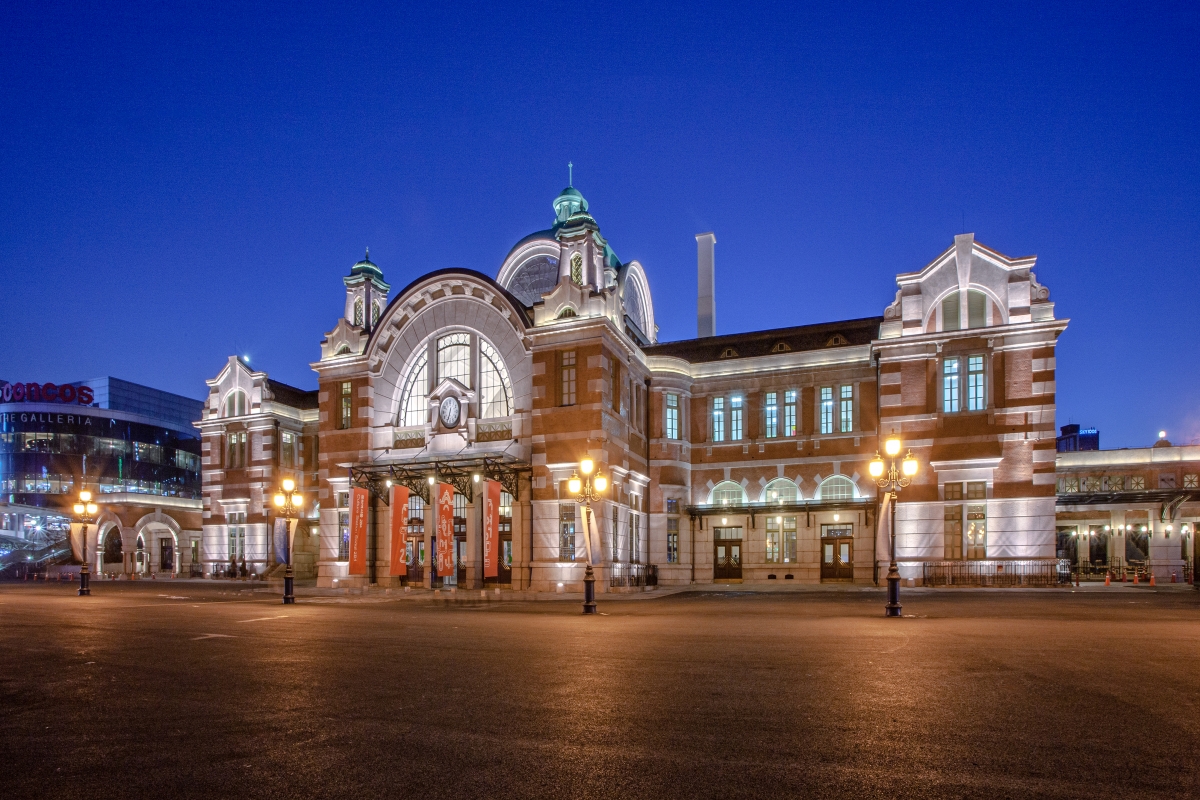
The former Seoul Station, now transformed into an art gallery / ©Chin Hyosook
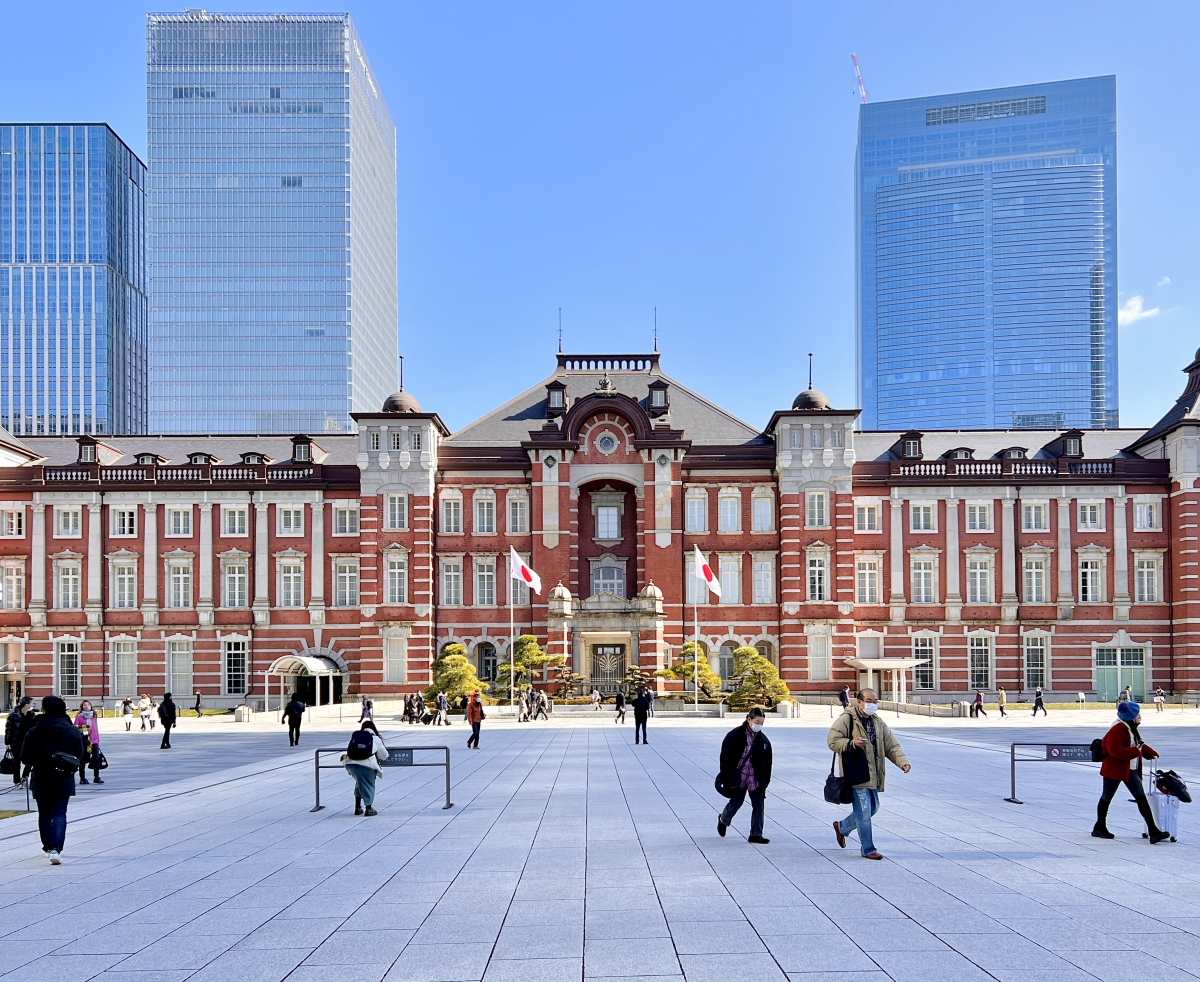
The restored Tokyo Station. A 20-metre-wide landscape control area placed at the central entrance (the former entrance for imperial family)
prevents the construction of high-rise buildings right behind. / ©Kim Youngjoon
Lee: In the case of Seoul Station, while building a new station fit for the high-speed rail era, we failed to give serious consideration to keeping old building’s function as a station, separating it from its original function as a cultural space in terms of preserving cultural properties. Seoul Station has been converted to another purpose rather than used for its original purpose. Tokyo Station, which is older than Seoul Station, was newly restored while maintaining its original function, and a hotel in the original station was restored to its former glory. From the window of the hotel room, guests witness commuters passing through the terminal. I think restoration and prioritising original use like this is the much better approach. On the other hand, the transformation of old Seoul Station into a cultural space is far from the romance achieved by the Musée d’Orsay in Paris.
Yoon: When we examine what enabled restoration of Tokyo Station, we shouldn’t separate the building from its surroundings. The regeneration of Marunouchi paved the way for restoration as it revived commercial power. They included its surroundings from the perspective of regeneration. The Hilton Hotel is in a similar situation. Connected to Seoul Station and Namsan Mountain, it shouldn’t be considered as an individual building, and reorganisation of the business district of Seoul Station should be taken into account, which includes the Hilton Hotel. In addition to the perspective of architectural history, urban design should also be factored into discussion. These days, when I attend meetings on regeneration projects in the Ministry of Public Administration and Security, the Ministry of Land, Infrastructure and Transport, and the Ministry of Culture, Sports and Tourism, I found that most of them target water purification plants and garbage incineration plants. I wonder if such sites can be also a subject of this discussion. I would like to ask whether we should limit the criteria for judging heritage architecture to those that have apparent meaning to architectural history.
Hwang: I think they are included. Buildings designed by renowned architects and buildings that are not―it doesn’t if designers stand on opposite sides. There is the variable of time, and it is necessary to discuss each site as a record of its time. In that regard, a humanistic imagination, or in other words the ability to create a narrative about an object, is important. So, the issues of heritage preservation are ever present. Productive discussions will be made possible only when we acknowledge that the starting points can vary.
Choi: From an economic point of view alone, redevelopment is always the right answer. However, if a majority agree to preservation, it is right for the public to fill the gaps that cannot satisfy economic value.
Lee: In Japan, reconstruction for reduction is a recent trend. I think we will follow it soon. Reconstruction of an existing 500 households can yield only 300. There are no more people to live in. However, additional expenses during this process are supported by local government. Only this enables development.
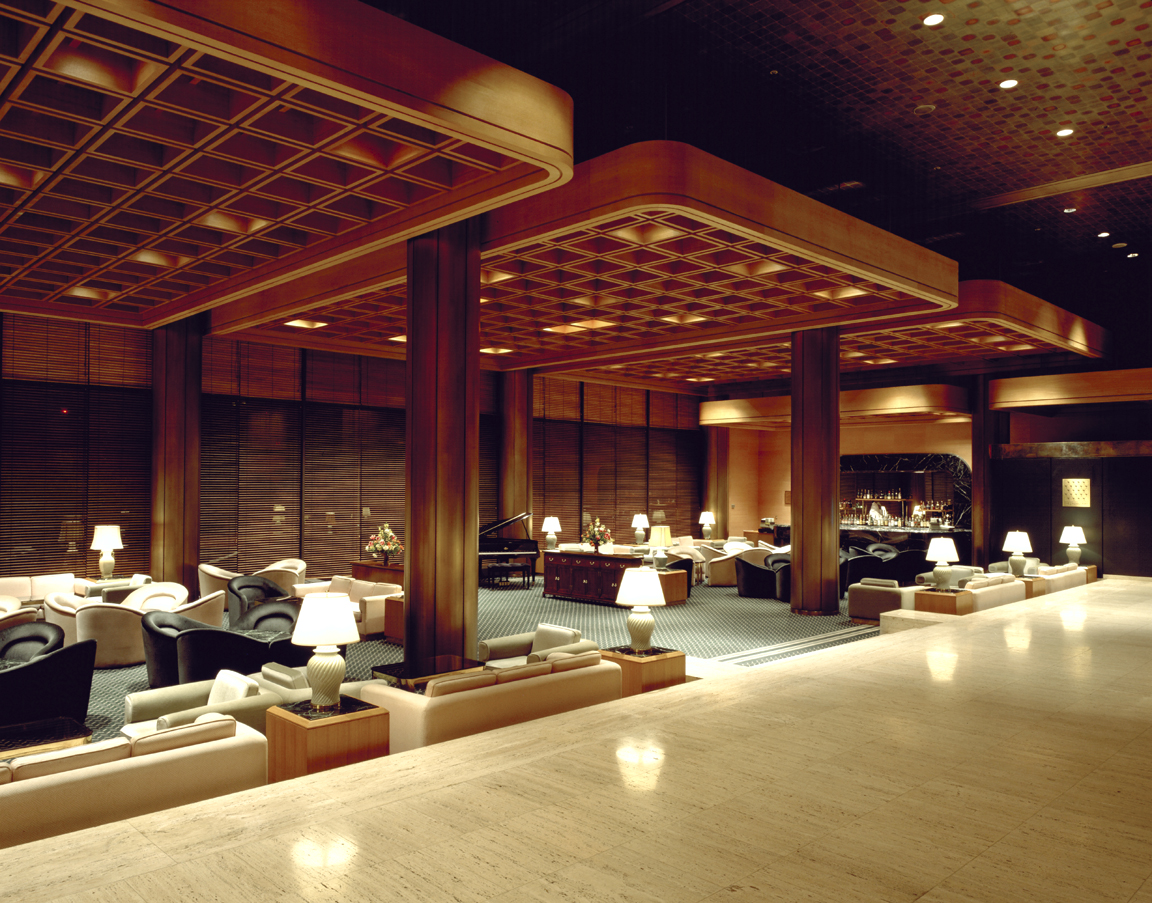
The Hilton Hotel used Travertine on the floor and bronze on the columns. / ©Lim Chung Eui
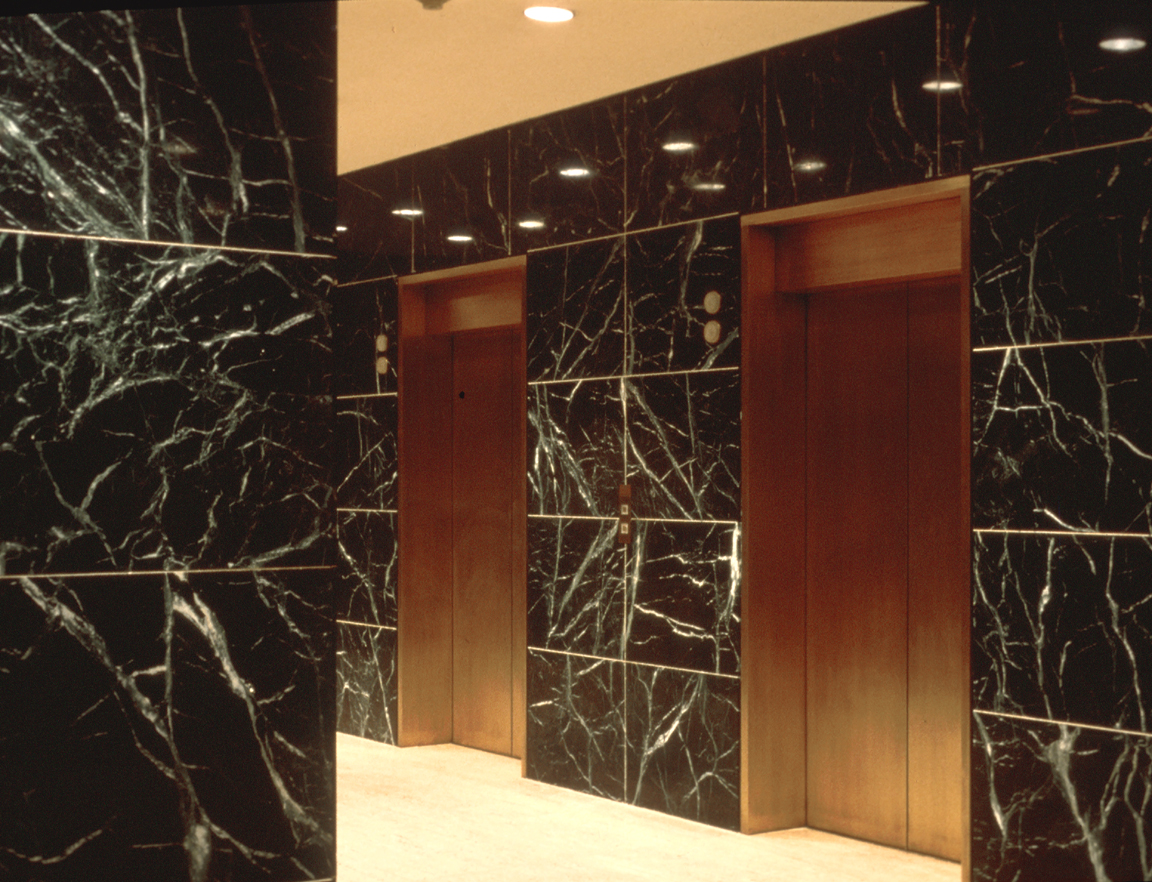
Green marble used in the interior of the Hilton Hotel / ©Lim Chung Eui
Yoon: When I visited the Hilton Hotel, what impressed me was the interior materials, which were replete with memories and tactility. If interior features, such as doors, furniture, lighting, and marble, are to be separated and used in the regeneration of nearby buildings, the entire neighbourhood will flood into the hotel. (laughs) If the building can’t survive, I hope we can save the materials and use them to tell a story. The story of a neighbourhood can change drastically with just one word: this door and lighting is from the Hilton Hotel. Spreading the DNA of Hilton Hotel throughout the neighbourhood and continuing its link to architectural heritage would prove to be a wonderful means of regeneration.
Choi: If we give economic value to the material itself, we can’t escape from an economic logic. As mentioned earlier, we should approach this in terms of protecting the environment. We have to adhere to a principle that doesn’t produce new materials or elements regardless of methods. The ‘ZIN in No(o)rd’ project in Brussels among the works participating in Guest Cities Exhibition of Seoul Biennale of Architecture and Urbanism 2021, presented the recycling project of office buildings built in the 1970s that had been deemed worthless. They had the principle of 100% recycling of materials. All new materials were also recycled. From this point of view, the minimum change is the way of protecting our environment in the case of Hilton Hotel. Mies van der Rohe’s New National Gallery in Berlin also went through the process of disassembling and reassembling one-by-one.
Yoon: The conservation of Isejingu Shrines in Japan do not retain the temples themselves, but regularly dismantle and move them to preserve the construction technology. They target the method.
Hwang: I think we need to ask the question, ‘What is the subject of preservation and how do we begin to detail it?’ I don’t think it means that one door handle or wallpaper cannot be changed, as in the case of Gyeongbokgung Palace. Conversely, dismantling a building and sending its elements to other areas, like spreading genes, may feel like a compelling rhetorical device but it is also quite an extreme approach. I think we can find a solution somewhere in between.
Institutional Devices and Communicative Processes
Lee: In the context of the coexistence between development and conservation, the public can play a very important role. For example, the future of the Hilton Hotel will also depend on master plan or the city management plan of the local government in that it is included in a redevelopment area. Remodeling of Samil Building is recently completed. It could extend the building use without compromising Kim Chung-up’s design intentions. The building could survive as the floor area ratio of the existing building was about 1700%, which couldn’t be secured in a case of demolition and reconstruction. The Gongpyeong Building project, which lead to the discovery of buried ruins during construction, created a Historic Sites Museum with institutionally relaxed floor area ratio and height limit. As the city of Seoul has experienced such cases frequently enough, it would be appropriate to apply this to the Hilton Hotel as well. While problems were solved after they came to the fore during development process in the past, the process should go through such discussion preemptively. Seoul can find a contextual fit for the discussion as they have experience of successful cases.
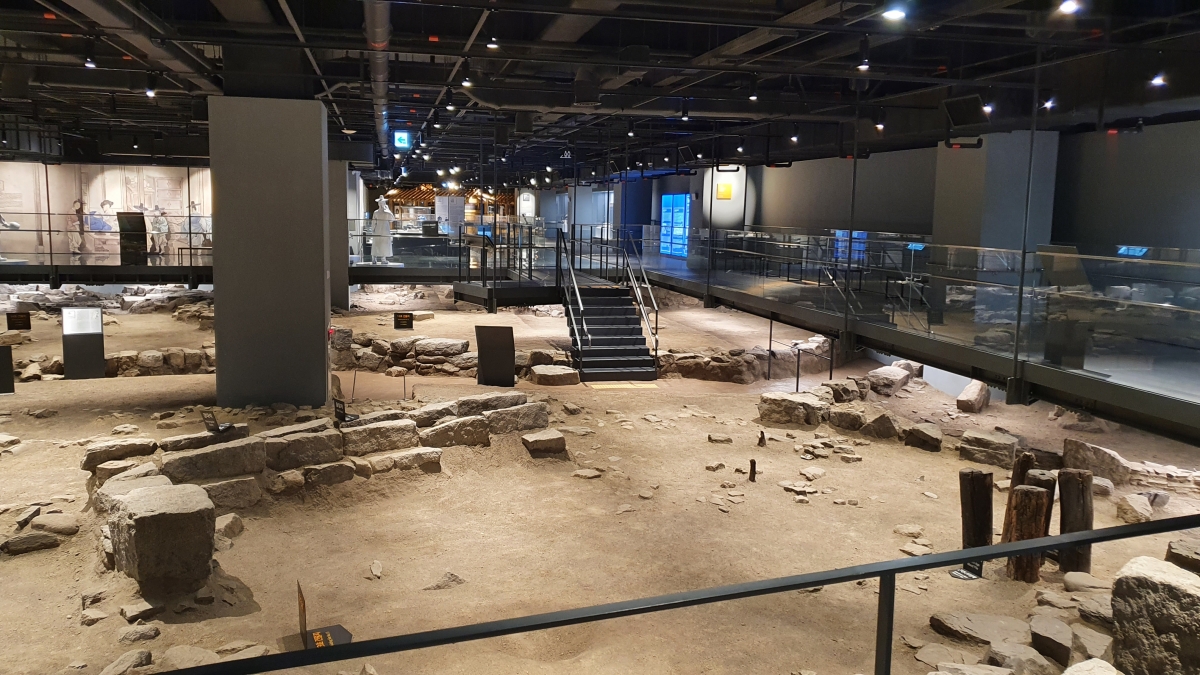
Gongpyeong Historic Sites Museum / ©Kim Saehoon
Hwang: The issue of ‘who can decide’ is also important. The opinions of experts in the field, even if there are only a few, are still important. The alternative would be a kind of popular vote targeting unspecified individuals, but perhaps the infrastructure facilities mentioned above would not have survived if their architectural value was evaluated through such a process. Again, this issue needs to be viewed in terms of diversity and complementarity, not as an antagonistic relationship like that between ‘specialists and ordinary people’. The expert should provide a more precise core rationale when advocating the preservation of a building, such as physical qualities, historical values, or whether historical values can outweigh architectural value of the building. Some young Korean architects put their head into the lion’s mouth following the Japanese colonial period, losing the opportunity to communicate directly with world architecture. First, Kim Chung-up went to Le Corbusier, then Kimm Jong-soung to Mies van der Rohe, and Tai Soo Kim to Louis Kahn but learned from Paul Rudolph as Kahn left the school. The young architects digested what they learned at these centres of world architecture, and presented some masterpieces recognised on an international level as at a level of perfection beyond dispute, one of which is the Hilton Hotel. This perspective is also connected to the modern history of Korea in general. This building clearly has an aspect as a record of an era, and its narrative means a lot to me.
Yoon: I think it is right for experts to start this conservation. However, I hope that the scope of expertise will cover not only architecture and art but also of the climate, small business owners, developers, and gender. In addition, the discussion initiated by experts should not conclude between them, but rather it should expand out through the process of wider communication that creates a consensus with the public. From an institutional point of view, direct financial support provided by the public is difficult to make a list and it will make fundraising impossible. I hope that the public sector will take charge of local investigations, legal review, building information transmission, and archiving of memories of residents, which can’t be covered by the private sector due to lack of money and time. In particular, few data sets are available on areas other than Seoul. Then, it is difficult to commence with ease because the project operator must begin from scratch. Many buildings are left to collapse due to a lack of business potential and information.
Choi: The approach of considering a building as an asset or heritage site seems to leave few choices. When it is regarded as an ecological entity, leaving it as it is is the answer in most situations. Providing any further public support or institutional devices require a social reason. Historical debates usually make things more challenging as we tend to focus on the past. History is not a retrospective view relying on the memories of a specific person or group, but a vision of our society and the cities of the future presented and edited by historians. The editing process of history means we come to make decisions about what we should protect, but a story focused solely on the past makes us judge that memory is more precious than other aspects. I think we should pay more attention to what kind of city would be right for the future, rather than discussing history endlessly. This will lead us to more buildings to be preserved.




